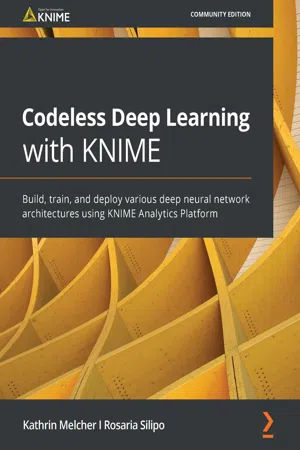
Codeless Deep Learning with KNIME
Build, train, and deploy various deep neural network architectures using KNIME Analytics Platform
Kathrin Melcher, Rosaria Silipo
- 384 Seiten
- English
- ePUB (handyfreundlich)
- Über iOS und Android verfügbar
Codeless Deep Learning with KNIME
Build, train, and deploy various deep neural network architectures using KNIME Analytics Platform
Kathrin Melcher, Rosaria Silipo
Über dieses Buch
Discover how to integrate KNIME Analytics Platform with deep learning libraries to implement artificial intelligence solutions
Key Features
- Become well-versed with KNIME Analytics Platform to perform codeless deep learning
- Design and build deep learning workflows quickly and more easily using the KNIME GUI
- Discover different deployment options without using a single line of code with KNIME Analytics Platform
Book Description
KNIME Analytics Platform is an open source software used to create and design data science workflows. This book is a comprehensive guide to the KNIME GUI and KNIME deep learning integration, helping you build neural network models without writing any code. It'll guide you in building simple and complex neural networks through practical and creative solutions for solving real-world data problems.
Starting with an introduction to KNIME Analytics Platform, you'll get an overview of simple feed-forward networks for solving simple classification problems on relatively small datasets. You'll then move on to build, train, test, and deploy more complex networks, such as autoencoders, recurrent neural networks (RNNs), long short-term memory (LSTM), and convolutional neural networks (CNNs). In each chapter, depending on the network and use case, you'll learn how to prepare data, encode incoming data, and apply best practices.
By the end of this book, you'll have learned how to design a variety of different neural architectures and will be able to train, test, and deploy the final network.
What you will learn
- Use various common nodes to transform your data into the right structure suitable for training a neural network
- Understand neural network techniques such as loss functions, backpropagation, and hyperparameters
- Prepare and encode data appropriately to feed it into the network
- Build and train a classic feedforward network
- Develop and optimize an autoencoder network for outlier detection
- Implement deep learning networks such as CNNs, RNNs, and LSTM with the help of practical examples
- Deploy a trained deep learning network on real-world data
Who this book is for
This book is for data analysts, data scientists, and deep learning developers who are not well-versed in Python but want to learn how to use KNIME GUI to build, train, test, and deploy neural networks with different architectures. The practical implementations shown in the book do not require coding or any knowledge of dedicated scripts, so you can easily implement your knowledge into practical applications. No prior experience of using KNIME is required to get started with this book.
Häufig gestellte Fragen
Information
Section 1: Feedforward Neural Networks and KNIME Deep Learning Extension
- Chapter 1, Introduction to Deep Learning with KNIME Analytics Platform
- Chapter 2, Data Access and Preprocessing with KNIME Analytics Platform
- Chapter 3, Getting Started with Neural Networks
- Chapter 4, Building and Training a Feedforward Neural Network
Chapter 1: Introduction to Deep Learning with KNIME Analytics Platform
- The Importance of Deep Learning
- Exploring KNIME Software
- Exploring KNIME Analytics Platform
- Installing KNIME Deep Learning – Keras Integration
- Goals and Structure of this Book
The Importance of Deep Learning
Exploring KNIME Software
KNIME Analytics Platform
Inhaltsverzeichnis
- Codeless Deep Learning with KNIME
- Why subscribe?
- Preface
- Section 1: Feedforward Neural Networks and KNIME Deep Learning Extension
- Chapter 1: Introduction to Deep Learning with KNIME Analytics Platform
- Chapter 2: Data Access and Preprocessing with KNIME Analytics Platform
- Chapter 3: Getting Started with Neural Networks
- Chapter 4: Building and Training a Feedforward Neural Network
- Section 2: Deep Learning Networks
- Chapter 5: Autoencoder for Fraud Detection
- Chapter 6: Recurrent Neural Networks for Demand Prediction
- Chapter 7: Implementing NLP Applications
- Chapter 8: Neural Machine Translation
- Chapter 9: Convolutional Neural Networks for Image Classification
- Section 3: Deployment and Productionizing
- Chapter 10: Deploying a Deep Learning Network
- Chapter 11: Best Practices and Other Deployment Options
- Other Books You May Enjoy